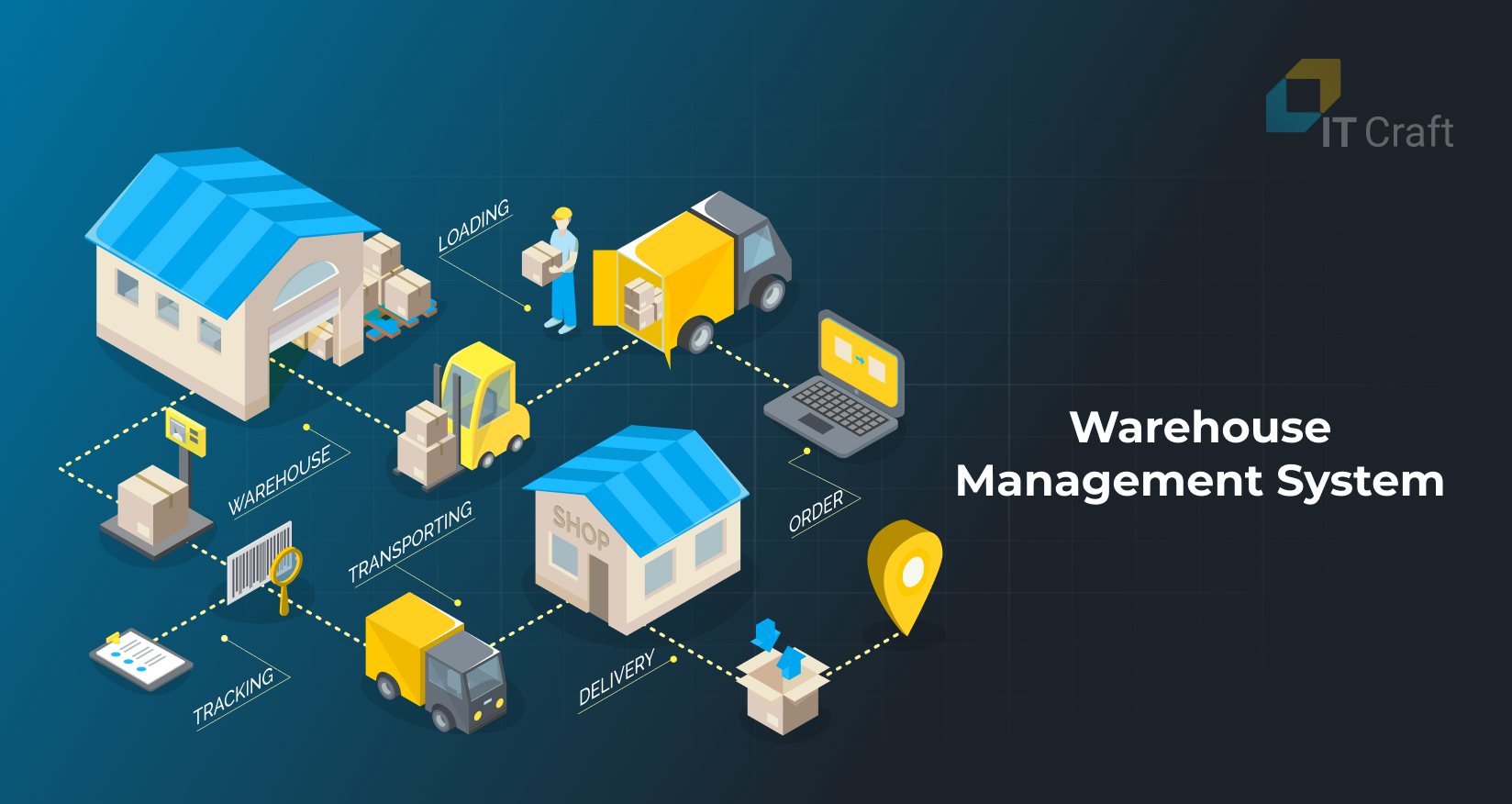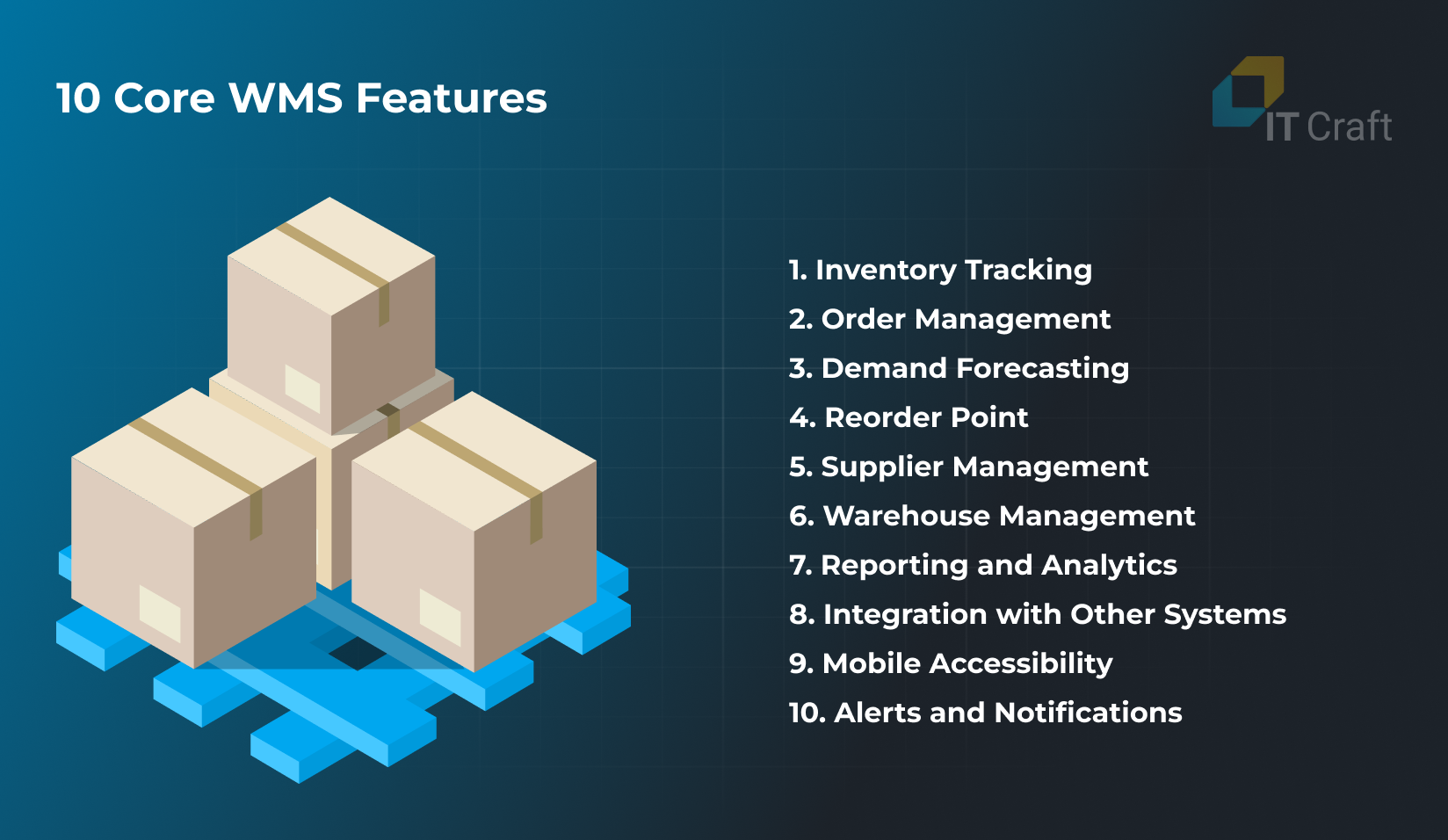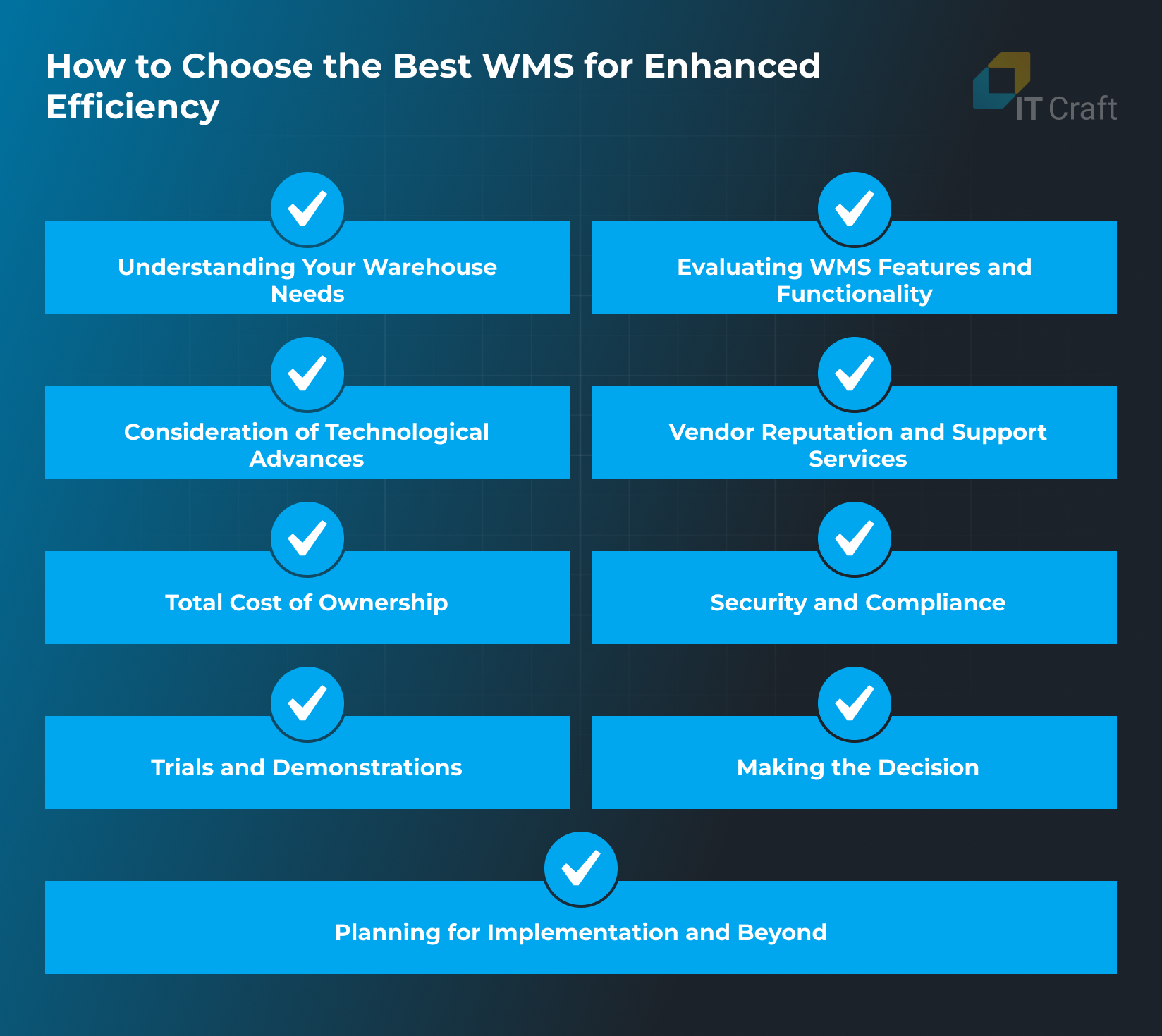In the complex world of logistics, a Warehouse Management System (WMS) is crucial for efficiency and productivity, a testament to the importance of logistics software development.
As the digital core of inventory operations, WMS manages everything from receiving to shipping with precision.
Notably, 87% of warehousing, logistics, and retail leaders are either currently expanding or planning to expand their warehouses by 2024, highlighting the growing need for advanced logistics software solutions.
A sophisticated WMS ensures speed, accuracy, and customer satisfaction in modern logistics. Logistics companies risk inefficiencies and errors without such a system, underscoring the significance of investing in high-quality logistics software development.
1
What is a Warehouse Management System?

Exploring what is a Warehouse Management System (WMS) reveals its role as a vital tool in the logistics industry, central to managing warehouse operations efficiently. The worldwide market size for warehouse management systems is projected to grow at a Compound Annual Growth Rate (CAGR) of 16.1% between 2022 and 2030.
If we want to define a Warehouse Management System (WMS), it is a software solution designed to optimize warehouse operations. It acts as the nerve center, directing the storage, movement, and handling of goods within a warehouse, ensuring they are processed most efficiently.
This integration of technology streamlines operations, minimizes errors, and can significantly reduce labor costs, highlighting its role as an indispensable cog in modern logistics and supply chain management.
Now that we’ve delved into Warehouse Management Systems and their pivotal role in streamlining warehouse operations, you can broaden your perspective by exploring our Logistics Management Software article.
2
Benefits and features of a robust WMS

Understanding a Warehouse Management System helps recognize how it streamlines processes from inventory control to order fulfillment, playing a critical role in modern logistics and supply chain management.
A robust WMS provides flexibility and comprehensive control in a high-velocity logistical framework by enabling real-time, accurate oversight of warehouse operations.
Comprehensive Inventory Management
Contemporary WMS solutions break away from outdated spreadsheet models, facilitating seamless integration across various storage facilities and supply chain nodes. This integration gives warehouse managers real-time access to crucial inventory data, spanning the movement of goods from manufacturers to warehouses, distributors, and customers.
When paired with accounting software, WMS provides instant access to financial data, such as unit costs and overall inventory values.
The precision of live data capture is a significant upgrade over past methods, allowing for meticulous stock level tracking and substantially diminishing the risks associated with overstocking or depletion, particularly during critical, high-activity periods.
Optimization of Warehouse Operations
The most effective WMS provides a broad range of customizable options for inventory management, from logging methodologies to task assignments and even the nitty-gritty of picking processes.
Whether it’s leveraging smart scales, utilizing RFID technology for scanning, or employing sophisticated picking strategies like batch, zone, or wave picking, these systems can be tailored to suit the unique requirements of each warehouse operation.
Integration with Transportation Management Systems (TMS) further refines the incoming and outgoing freight management, enhancing the cohesion and synchronization between the various moving parts of warehouse logistics.
Adopting and integrating these innovative solutions and technologies dramatically improves operational efficiency, reducing errors and eliminating unnecessary delays, thus facilitating a smoother and more streamlined workflow.
Strengthening Team and Client Relations
The impact of a well-chosen WMS extends beyond process improvements—it profoundly affects personnel and client relations. With clearer role definitions and streamlined operations, staff members often experience increased job satisfaction, autonomy, and accountability.
Moreover, the real-time performance monitoring facilitated by WMS enables managers to provide prompt and tailored support and training, meeting the individual requirements of each team member. As in-house efficiency climbs, so does the quality of interaction with suppliers and clients.
Error reduction and dependable inventory tracking result in smoother transactions and heightened satisfaction among business partners and customers.
Cost Savings and Operational Efficacy
The financial benefits of an efficient WMS are compelling. Streamlining operations is synonymous with cost savings in an industry where time equates to money. Delays and errors can be costly due to mismanaged orders, inefficient layout, or suboptimal picking and packing.
A Warehouse Management System (WMS) boosts supply chain transparency and efficiency, optimizing space, labor, and resources for increased productivity. A properly implemented WMS not only organizes warehouses but also improves profitability.
Adopting a suitable WMS is essential for modernizing warehouses and keeping up with evolving logistics technology, offering scalability to meet current and future challenges in the industry.
Discover how a powerful WMS can transform your logistics.
Experience efficiency like never before.
Contact Us
3
Types of Warehouse Management System
Understanding the different types of Warehouse Management Systems (WMS) is crucial for businesses to choose the right system that aligns with their operational needs, size, and complexity.
Each type offers unique features and capabilities that cater to various logistical requirements. Below, we explore the predominant WMS types that modern businesses utilize to enhance their logistical operations.
Standalone WMS
A Standalone Warehouse Management System is a specialized solution focusing solely on warehouse operations. Its primary purpose is to manage inventory levels, optimize picking and packing processes, and streamline the receipt and shipping of goods.
This system is particularly beneficial for small to mid-sized businesses requiring robust warehouse management capabilities without the complexities and costs associated with larger, more integrated systems. It offers simplicity and ease of use, often resulting in a shorter implementation period and significantly reduced training time for warehouse staff.
Standalone systems are also typically easier to customize to the specific needs of a warehouse, making them a flexible option for businesses with unique operational requirements.
Cloud-Based WMS
MarketsandMarkets reports that cloud-based warehousing is expanding swiftly, with a Compound Annual Growth Rate (CAGR) of 22.3%. Cloud-Based Warehouse Management Systems represent a modern approach to warehouse operations, providing the flexibility of remote accessibility.
The cloud-based model is flexible and grows with your business. It’s good for companies that are expanding or have changing needs. It cuts down on the market for much money upfront and for regular upkeep because the service provider usually takes care of updates and infrastructure.
Supply Chain Modules
Supply Chain Modules within a Warehouse Management System are designed for comprehensive oversight of the entire supply chain. These modules extend the functionality of a standard WMS to include supply chain execution capabilities.
These systems help businesses coordinate their warehouse activities with the whole supply chain. This ensures a clear and connected movement of information and materials from suppliers to customers. They are good for big companies that handle complicated logistics and must keep all parts of their supply chain closely connected.
Integrated ERP WMS
An Integrated ERP (Enterprise Resource Planning) system with WMS capabilities provides a unified solution for managing not just warehouse operations but all aspects of a business. This integration encompasses financials, human resources, customer relations, and inventory management.
An ERP with integrated WMS connects warehouse operations with other business areas, streamlining processes and ensuring consistent information flow. This approach aids in informed decision-making and suits businesses seeking a comprehensive view of operations focusing on specific warehouse activities.
While exploring the various types of Warehouse Management Systems gives us insight into optimizing warehouse operations, understanding Transportation Management Systems (TMS) is equally crucial for comprehensively managing the broader logistics and supply chain management spectrum.
4
How to Choose the Best WMS for Efficiency
Selecting the best Warehouse Management System (WMS) for your business is a critical decision that can greatly impact your operational efficiency. The right WMS will streamline your processes, reduce costs, and improve customer satisfaction.
To ensure you choose the best WMS for your needs, consider the following factors:
- Assess Your Business Needs: Understand your current operational challenges and what you want to achieve with a new WMS. Consider inventory volume, turnover rates, and the complexity of your supply chain.
- Scalability and Flexibility: Your chosen WMS should meet your current requirements and grow with your business. It should be flexible enough to adapt to changing business environments and customer demands.
- Integration Capabilities: Look for a system that can integrate seamlessly with your existing technology stack, including ERP systems, accounting software, and e-commerce platforms.
- User-Friendly Interface: A WMS with an intuitive user interface will reduce training time and help your staff to adapt quickly to the new system.
- Functionality and Features: Prioritize the features that are most important to your operations, such as real-time inventory tracking, labor management, reporting capabilities, and order management.
- Vendor Reputation and Support: Choose a vendor with a solid reputation and a proven track record. Good customer support is crucial for resolving any issues that may arise.
- Cost: While cost should not be the only factor, you must consider your budget constraints. Evaluate the total cost of ownership, including implementation, training, and maintenance fees.
- Compliance and Security: Ensure the WMS complies with industry standards and regulations. Data security is paramount, so check the security features the system offers.By taking a strategic approach to choosing a WMS, you can ensure that you select a system that aligns with your business goals and drives efficiency.
Want to elevate your warehouse efficiency with the right WMS?
Reach out to us today for expert guidance and find the perfect solution for your needs.
Contact Us
5
How to Choose the Best WMS for Enhanced Efficiency
In today’s fast-paced business environment, an efficient Warehouse Management System (WMS) is not just a luxury—it’s a necessity. The right WMS can dramatically improve warehouse operations, providing the competitive edge needed to thrive.
A comprehensive evaluation strategy is essential to navigate the complex landscape of WMS options and find the best fit for your business.

Understanding Your Warehouse Needs
Before exploring WMS solutions, it’s crucial to understand your warehouse’s specific needs clearly. Assess your current workflow, identify bottlenecks, and pinpoint your staff’s challenges.
Consider the size of your warehouse, the variety of products stored, the volume of orders processed, and any unique industry requirements, such as lot tracking for pharmaceuticals or cold storage for perishables.
Evaluating WMS Features and Functionality
Evaluate WMS features critically—prioritize them based on how they can address your specific needs. Essential functionalities to consider include:
- Inventory Visibility: Real-time tracking of inventory across multiple locations.
- Order Management: Automated picking, packing, and shipping with efficient order fulfillment workflows.
- Reporting and Analytics: Insights into operations, inventory levels, and staff performance.
- Integration Capabilities: Seamless integration with existing ERP, CRM, and supply chain management systems.
- Scalability: The ability to support your business growth without needing a system overhaul.
- User Interface: Intuitive and user-friendly design that can reduce training time and errors.
- Customization: Flexibility to customize according to your specific warehouse processes.
Consideration of Technological Advances
The WMS you choose should be built on modern technology and capable of incorporating advancements such as AI, machine learning, and the Internet of Things (IoT). These technologies can further optimize warehouse operations and prepare your business for future challenges.
Statista forecasts that by 2025, the number of devices connected to the Internet of Things (IoT) will reach a staggering 30.9 billion, a significant jump from just 0.8 billion in 2010.
Vendor Reputation and Support Services
The reliability of a WMS also hinges on the vendor’s reputation and the support services they offer. Look for vendors with proven track records, case studies, or testimonials from existing customers. Post-implementation support, regular updates, and training resources are indicators of a vendor committed to long-term client success.
Total Cost of Ownership
While initial costs are a significant factor, the total cost of ownership (TCO) over time truly impacts your budget. Consider not only the software purchase price or subscription costs but also the expenses related to implementation, hardware (if necessary), training, support, and upgrades.
Security and Compliance
With data breaches posing a significant risk, ensure that your chosen WMS has robust security protocols. Additionally, it must comply with industry regulations and standards to safeguard your business against legal and financial repercussions.
Trials and Demonstrations
Once you’ve narrowed your options, arrange for demonstrations and, if possible, a trial period. This hands-on experience will provide invaluable insight into how the WMS will perform in your work environment.
Making the Decision
Gathering feedback from your team during the evaluation phase is vital—they are the end-users whose day-to-day operations will most affect the new system. Consider creating a selection committee representing various departments to ensure all perspectives are considered.
Planning for Implementation and Beyond
Finally, the selection of a WMS is just the beginning. Plan for a thoughtful implementation phase with adequate training and support. It’s also wise to consider the long-term relationship with the vendor and how they will help your business adapt as new logistics and supply chain challenges arise.
By thoroughly examining these aspects, businesses can make an informed decision when selecting a WMS, leading to improved efficiency, reduced costs, and enhanced service levels. Remember, the best WMS for your business is one that not only solves today’s challenges but also supports tomorrow’s opportunities.
6
The Key Warehouse Processes
Effective warehouse management revolves around optimizing several key processes that drive efficiency, accuracy, and productivity. Understanding and refining these processes is vital for a well-functioning warehouse.

Receiving Goods
The receiving process is the first step in the warehouse workflow. Accuracy here is critical; errors can ripple through subsequent operations. It involves unloading goods, quality inspections, recording inventory, and updating systems to reflect new stock.
Inventory Storage
Once goods are received, they must be stored efficiently. Proper storage involves organizing goods to maximize space utilization while ensuring easy access for picking. High-demand items are often placed closer to the picking areas to speed up the process.
Order Picking
Picking is collecting items from their storage locations to fulfill customer orders. This labor-intensive process is often optimized through various methodologies like zone, wave, or batch picking to reduce travel time and increase efficiency.
Packing
After picking, items are packed for shipment. This step must ensure that the products are securely packaged to prevent damage during transport but not over-packaged to save on material costs. The packing process also includes weighing and labeling for shipping.
Shipping
The shipping process involves the preparation of items for delivery to the customer. This can include consolidating items into shipping containers, generating shipping documents, and scheduling carriers. Timeliness and accuracy are crucial to maintaining customer satisfaction.
Inventory Control and Management
Effective inventory management ensures that stock levels are maintained to meet demand without overstocking. This process involves cycle counting, monitoring inventory levels, and using data analytics to predict future inventory needs.
Returns Processing
Handling returns efficiently is essential for customer service. This process includes receiving returned items, assessing their condition, restocking or disposing of them, and managing refunds or replacements.
Quality Control
Quality control processes are integrated throughout the warehouse operations to ensure that the goods stored, picked, packed, and shipped meet the required standards. This minimizes the risk of defective or damaged goods reaching the customer.
Warehouse Safety and Maintenance
Safety procedures are vital to protect workers and goods. Regular equipment and facility maintenance ensures a safe working environment and minimizes the risk of operation interruptions.
Continuous Improvement
Continuous analysis of warehouse processes and implementing improvements are essential to remain efficient and competitive. This includes staying updated with the latest warehouse management technologies and best practices.
By focusing on these key processes, warehouses can streamline operations, minimize errors, and adapt to changing demands, ultimately leading to a more efficient and productive operation.
7
IT Craft Expertise
In the realm of Warehouse Management Systems (WMS), IT Craft stands out for its exceptional expertise and innovative solutions.
Our approach to WMS is not just about managing warehouses efficiently; it’s about transforming them into pivotal elements of the logistics supply chain.
ITCraft's Role in Elevating MyCarrierTMS in the Logistics Sector

ITCraft has played a crucial role in the growth and success of MyCarrierTMS, a leading platform in transportation management focusing on truckload shipments. Their collaboration, starting in 2017, has led to remarkable advancements in the logistics field.
Working alongside MyCarrierTMS, ITCraft set out to develop an innovative web solution that would transform the logistics industry. The goal was to simplify and enhance the process of connecting shippers with carriers, making the booking, coordinating, and tracking less-than-truckload shipments more efficient.
This partnership resulted in the development of a groundbreaking web solution, confirming the viability of MyCarrierTMS’s business model. The operation experienced notable growth, attracting multiple funding rounds. The project then shifted its focus to cloud integration for improved scalability.
Product Development and Financial Milestones:
The team initiated a Minimum Viable Product (MVP) for less-than-truckload shipments and successfully secured funding of $36.8 million.
Achievements in the Industry:
MyCarrier has been recognized with the FreightWaves FreightTech 25 Award and has also been acclaimed as the top TMS software by G2, marking its prominence in the industry.
eLaundry: Revolutionizing Commercial Laundry Services

ITCraft has played an integral role in the success and evolution of eLaundry, an innovative CRM software for on-demand laundry services catering to commercial clients in NYC. This collaboration, ongoing since 2014, has significantly transformed how laundry services are managed and delivered.
Together with eLaundry, ITCraft developed a comprehensive CRM system to automate and streamline all aspects of the laundry process. This includes scheduling, order pickup, calculating service rates, planning driver routes, and more, specifically tailored for commercial clients such as restaurants, hotels, and cafés.
Project Highlights & Achievements:
- Custom CRM Solution: A fully customized system addressing all facets of commercial laundry management.
- Business Growth: Significant operational expansion, supported by robust software solutions.
- Technological Advancements: Utilizing technologies like JavaScript, Java, Yii2, and MySQL to create a seamless experience.
- Market Adaptation: The system was initially designed for individual users and later successfully adapted to meet the growing demands of business clients.
Impact and Recognition:
- Operational Efficiency: The CRM system has drastically improved business processes, providing real-time monitoring and management capabilities.
- Industry Adaptability: eLaundry’s ability to pivot towards B2B services demonstrates its versatility and responsiveness to market needs.
!
Conclusion
Integrating a Warehouse Management System (WMS) is pivotal for modern logistics. It bolsters warehouse operations’ efficiency, accuracy, and cost-effectiveness, directly impacting customer satisfaction and competitive edge. As we’ve explored, choosing the right WMS hinges on understanding key warehouse processes and aligning them with business goals, a specialty of IT Craft.
The future of warehousing lies in embracing innovations like AI and IoT; a WMS is a foundational step toward this tech-forward approach. IT Craft’s expertise ensures businesses meet industry benchmarks and prepare for future advancements.










